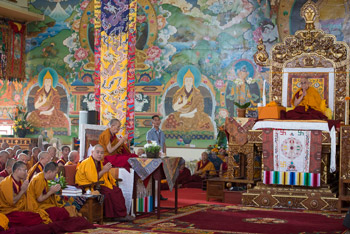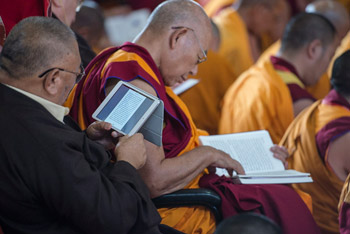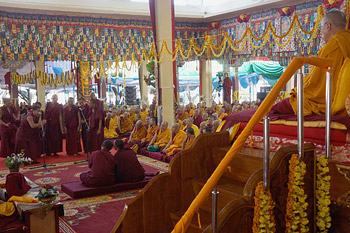Bylakuppe, Karnataka, India, 2 January 2014 - In addition to his public activities, such as the Lam Rim teachings he has been giving, His Holiness the Dalai Lama also meets with people before, in between and sometimes even after the teaching sessions. These may be groups from different places or individual monks and Lamas. Today, for example, before coming to the teaching ground, he met a group of more than a hundred Indian neo-Buddhists and a group of Bhutanese. In both cases he stressed what he often says elsewhere that one of the principal aims of Buddhism is the transformation of our disturbing emotions. To achieve this simple faith is not enough. What 21st century Buddhists need to do is study, which means reading or listening to teachings and thinking about them until you understand them. Both groups took avid interest in his advice.

|
His Holiness the Dalai Lama taking part in the opening prayers on the ninth day of his teachings at Sera Jey Monastery in Bylakuppe, Karnataka, January 2, 2014. Photo/Tenzin Choejor/OHHDL
|
In the three volumes he has been reading, the 'Sacred Words of Manjushri' the 'Southern Lineage' and the 'Swift Path' Lam Rim texts, His Holiness had completed the section dealing with calm abiding but was still reading about special insight. He said that among the three turnings of the wheel of Dharma, the Perfection of Wisdom teachings, the second turning of the wheel, are supreme. The Heart Sutra that had just been recited, and which he referred to as the ‘25 Verse Perfection of Wisdom Sutra’, describes both the Buddha and Avalokiteshvara as absorbed in concentration. In his initial teachings the Buddha taught how we are propelled into cyclic existence, but not who is propelled. The Heart Sutra teaches not only that the person is empty, but that the five aggregates that are its basis are also empty. His Holiness pointed out that the key word ‘also’ that is found in the Tibetan translation of the Heart Sutra, but not in the Japanese, Korean or Vietnamese versions, indicates that phenomena as well as persons are empty of inherent existence. The Perfection of Wisdom Sutras teach that there is no essence in anything, everything is empty of inherent existence and is merely designated, nominally existent.
“Because of ignorance of the nature of things, we are bound in cyclic existence. The Compassionate One led sentient beings by various means to an understanding of this. He taught about dependent origination to make it clear that things lack inherent existence. Je Tsongkhapa, founder of the Gelugpa tradition, cites great Indian masters like Nagarjuna who wrote that understanding emptiness is essential to overcome ignorance and the suffering that flows from it. And in order to understand what they wrote we need to study.
“We have the Three Seats of Learning where logic and epistemology are studied intensively. The Kadampas, those who initially followed Atisha in Tibet, passed down three lineages: the scriptural tradition, the oral transmission, and the pith instructions lineage. The Three Seats particularly uphold the scriptural or scholarly tradition.”

|
Members of the audience following the texts during His Holiness the Dalai Lama's ninth day of his teachings at Sera Jey Monastery in Bylakuppe, Karnataka, January 2, 2014. Photo/Tenzin Choejor/OHHDL
|
His Holiness stressed that we have the potential to reach enlightenment, essential to which is an understanding of emptiness. However, in our contemporary world, we have all kinds of distraction, so what we need is to understand the general structure of the teachings.
“Once we have an understanding of the Dharma and its structure we’ll be able to recognise the nature of cyclic existence. Trijang Rinpoche told me that when faced with distractions he viewed them as aspects of suffering. This is how teachers should teach and how practitioners should proceed. Across the world people are increasingly taking an interest in Buddhism. We need to support the lineage of Indian classics, for which study is important. Whatever depends on causes and conditions is seen to be empty.”
His Holiness switched to the ‘Southern Lineage’ and the ‘Swift Path’ Lam Rim texts and then back again to the ‘Sacred Words of Manjushri’ as they each explained the four ways of gathering disciples. He completed reading each of the texts and then embarked immediately on a reading of the ‘Essence of Nectar’, covering a small section of it before lunch and then resuming it afterwards. It begins with how to pay respect to the spiritual master. His Holiness recalled that when they reached this point when he first received transmission and explanation of the text, moved by thoughts of the kindness of his own teacher, his tutor Trijang Rinpoche wept for half an hour. The important thing, he said, is to implement the teacher’s advice in practice and in so doing to make this human life meaningful.
For auspicious reasons, after completing the ‘Essence of Nectar’ His Holiness made a start on reading ‘Zhamar Pandita’s Treatise on the Stages of the Path to Enlightenment’, but he said:
“Where we will meet for the next teaching is unknown because the future cannot be seen. I feel fortunate to have been able to give these teachings. I haven’t any experience of practice myself, but I’ve been able to pass on the lineage I’ve received.”

|
Monks debating in front of His Holiness the Dalai Lama at the end of the ninth day of his teachings at Sera Jey Monastery in Bylakuppe, Karnataka, January 2, 2014. Photo/Jeremy Russell/OHHDL
|
At His Holiness’s explicit request, the final hour of the afternoon was dedicated to debate. Groups of monks exhibited their skills not only before His Holiness but also in other parts of the ground. Two respondents sat on the ground, and teams of up to six monks stood and challenged them. Each debate began quietly enough, but, much as a fire begins to roar once it has taken, each contest rapidly became noisy and energetic. At the end, all who had taken part posed for a photograph with His Holiness.
Tomorrow, His Holiness will give an Avalokiteshvara empowerment, beginning his preparations from about 6.30am. Once the teachings are over, Speaker of the Assembly of Tibetan People’s Deputies Penpa Tsering, Kalon for Religious and Cultural Affairs, Pema Chinjor and former Kalon Tripa, Prof Samdhong Rinpoche will address the audience. 